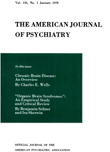THE ELECTROENCEPHALOGRAM IN KORSAKOFF SYNDROME
Abstract
1. The electroencephalograms were examined of 21 patients with a history of severe alcoholism and a confabulatory amnestic psychosis, nystagmus, and peripheral neuropathy.
2. The electroencephalographic findings were not characteristic of this syndrome: 17 showed abnormal tracings and there were 4 normal records. Of the abnormal records 15 contained a predominance of moderately slow activity, and 9 of these 15 showed a lesser degree of fast activity. Two individuals presented focal abnormalities that corresponded well with clinical and pneumoencephalographic evidence for cerebral trauma.
3. There was no direct correlation between the degree of the electroencephalographic abnormality and the degree and duration of the psychosis, the nystagmus, or the neuropathy.
4. The four patients who had convulsions also had cranio-cerebral injuries.
Access content
To read the fulltext, please use one of the options below to sign in or purchase access.- Personal login
- Institutional Login
- Sign in via OpenAthens
- Register for access
-
Please login/register if you wish to pair your device and check access availability.
Not a subscriber?
PsychiatryOnline subscription options offer access to the DSM-5 library, books, journals, CME, and patient resources. This all-in-one virtual library provides psychiatrists and mental health professionals with key resources for diagnosis, treatment, research, and professional development.
Need more help? PsychiatryOnline Customer Service may be reached by emailing [email protected] or by calling 800-368-5777 (in the U.S.) or 703-907-7322 (outside the U.S.).



